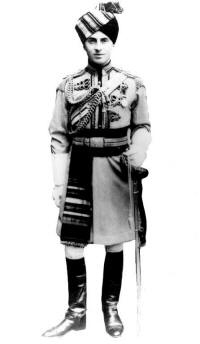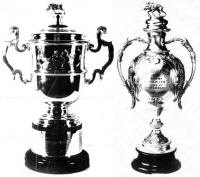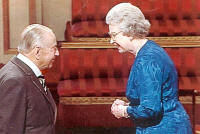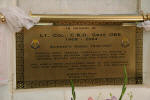
C. R. D. Gray wearing the Skinner's Horse full dress uniform when he was Aide-de-Camp to the Governor of Burma from 1935 to 1938.

The Kadir Cup - The Annual Challenge Trophy (displayed at the Cavalry and Guards Club) and The Winner's Trophy
Listen to an interview Douglas Gray gave to Mark Tully of the BBC, or download the mp3
Lt. Col. Douglas Gray, was an Indian Army officer with an outstanding record as a horseman; he was successful in many races and in 1934 won the Kadir Cup for individual pig-sticking.
After retiring from the Army, in 1970 Gray became Director of the National Stud, for which he acquired Mill Reef and other first-class horses, and became a founder member of the National Museum of Horseracing.
Aged 84, he was rewarded for his services to the bloodstock industry with the prestigious Devonshire Award.
Charles Robert Douglas Gray was born on December 31 1909 in Peking, where his father - himself a colonel, and a veteran of the Boxer Rebellion - was Medical Officer to the British Ambassador to China. Young Dougie was sent to Fettes, where his all-round sporting record was exceptional. He was in the 1st XV, the 1st XI for hockey (he was a Scottish schoolboy international in both sports) and in the shooting VIII; he also won the steeplechase and the 120 yards hurdles. Unfortunately, his games successes interfered with his academic achievements, and his father insisted on taking him out of Fettes, and putting him in a crammer in Sussex to ensure he passed into Sandhurst.
Having successfully arrived at Sandhurst, he was runner-up for the Saddle, acquitted himself with distinction at games and used his spare time for flying, acquiring a pilot's licence in 1930. After being commissioned into the Indian Army, Gray was attached to the Seaforth Highlanders for the statutory year and saw active service on the North West Frontier, notably in the Khajuri Plain campaign. In 1932 he was posted to Skinner's Horse (1st Duke of York's Cavalry), also known as the 1st Bengal Lancers, which was the only Commonwealth regiment to wear a yellow coat. Gray was in the regimental polo team, won the Lucknow Chase on Curragh Rose, and in 1934 won the Kadir Cup ("pronounced 'carder', as I once had to tell the Duke of Edinburgh").
Armed with a nine-foot lance, the pig-sticker rode a galloping horse in pursuit of wild boar which had been flushed out of the bush by beaters. The aim was to stick the boar immediately behind the shoulder, so that the spear would pass through the lungs and out at the breast. In 1880 Harper's New Monthly Magazine had declared: "One can scarcely imagine an Englishman so lost to all sense of decency as to shoot a fox, and next to that crime ranks, in Anglo-Indian estimation, the loathsome outrage of killing a pig by any process except that of pig-sticking"; the sport was "of inestimable value in developing the manly qualities of the British soldier". The quarry was quite unlike the pigs to which one was accustomed in England, these being "cowardly, weak, dirty and a prey to an inordinate thirst for swill". By contrast, their East Indian cousins (Sus Indicus) had been known "to attack and put to rout the majestic elephant and the ferocious tiger". Armed with long, semi-circular tusks, they might grow to five feet long and more than three feet tall at the shoulder; in speed they would "sometimes rival the fastest Arabian horse".
The Meeret Tent Club established the Kadir Cup in 1874, awarded to outstanding individual riders, and a Muttra Cup was inaugurated for team events based upon how much ‘pig’ teams of three could kill. Here is Pathe Footage of the 1934 Muttra and Kadir Cup (the grey horse is probably Granite, riden by Gray).
Gray considered his days' pig-sticking, on his horses Granite and Hermione, to have been the most exciting time of his life; it was, he said, more dangerous than big game hunting.
In 1936 he was appointed ADC to the Governor of Burma, returning to England after two years to ride his own horse, Emancipator, in the Grand Military Steeplechase at Sandown (finishing third) and in the Grand National (he fell at Becher's on the second circuit).
He went back to India to serve with his regiment in the Waziristan campaign, after which he was promoted captain and appointed quartermaster for the mechanisation of his regiment. In 1940 Skinner's Horse proceeded to the Sudan. Gray was now promoted again, to squadron commander, and served in the East African campaign, being wounded (though not evacuated) at the Battle of Keren. His regiment was a member of "Gazelle Force", a small, mixed unit, which in January 1941 was advancing into Eritrea, heading for Keren, when it met spirited Italian resistance in the Keru Gorge (a mile long, between 1,200ft- high granite walls).
Here on 21 January 1941, Gray witnessed a charge by 60 Italian cavalry led by an Italian officer on a white horse. It was repelled by a combination of artillery and revolver fire; the charge lasted about 30 minutes and ended when 12 of the attackers had been killed, and 16 wounded. Gazelle Force had six wounded. Skinner's Horse was astonished and impressed by this gallant charge, which was totally unexpected; the British Army had no idea that the Italians had any cavalry. Gray and his sowars had the ghastly task of putting down all the wounded horses.
Although this was not the last horsed cavalry charge made by either the British or Italians, it was the last occasion on which the British Army had to fight one off.
It should be noted that the Italian leader of the cavalry charge was not killed. He was Baron Amedeo Guillet - legend has it that the Baron leapt his horse over the guns to gallop from the field and escape. He escaped to Yemen, then Italy, and finally became a diplomat. He retired to Ireland in 1974. He and Douglas Gray met in Ireland 45 years after the cavalry charge. Amedeo Guillet died in 2010, in Rome.
The 'last cavalry charge' faced by the British Army has several accounts. Here are few:
- The Military Historical Society (1977)
- Sworn To Die: The History of Skinner’s Horse 1921-45 (M.A.R. Skinner) p120-121
- Memories of 2nd Lt. Kenneth Simonds (who was also in Keru Gorge) p7
At the conclusion of the campaign Gray attended the Staff College, Quetta, before being appointed to GHQ, New Delhi, as a Grade Two staff officer. In 1944 he returned to Skinner's Horse in Italy as second-in-command, and at the end of the war in Europe he was transferred to the Army Remount Service in India, then went to the Burma front with 7th Indian Division.
At the end of the war with Japan in August 1945, he was sent to Thailand to organise the disposal of all captured Japanese army animals. On completion of this task, he returned to New Delhi as GSO1 Remount Directorate.
In 1946 Gray was posted to command the Indian Army Remount Breeding Area in Montgomery (Punjab), putting him in charge of 75 stallions and 3,500 brood mares, supplying horses and mules for the Indian Army and civilian market.
After Independence and Partition in 1947, Gray returned to Britain and became manager of the Hadrian Stud at Newmarket. He also joined the TA, as a reserve officer in the 10th Royal Hussars.
While continuing to run the Hadrian Stud, Gray bought and ran (with his wife) the Stetchworth Park Stud, from 1960 to 1982. He sold it in order to become the first Director of the British racing school for stable staff at Newmarket (an unpaid appointment). The school was officially opened by the Prince and Princess of Wales in 1984.
Meanwhile, in 1970, Gray had been asked by Lord Wigg, chairman of the Horserace Betting Levy Board, to succeed Peter Burrell as Director of the National Stud. It was through Gray's American connections, established at Hadrian, that Paul Mellon's Mill Reef came to the National Stud.
Dougie Gray was energetically active in a wide variety of spheres. He was a member of the Thoroughbred Breeders' Association, the Bloodstock Industries' Committee, the Animal Health Trust and the National Museum of Horseracing. He was president of the Newmarket British Legion from 1955 to 1984; Poppy Appeal Organiser from 1970 to 1983 (nearly doubling the receipts); and president of the Suffolk branch of the British Legion from 1981 to 1984. He worked tirelessly for the welfare of the pensioners of the old Indian Army.
In 1998 he was appointed OBE.
A triple heart by-pass operation when he was 84, following hip replacements, did not prevent Gray from visiting India soon afterwards, or driving up to Edinburgh from Hampshire and back to attend an old boys' dinner at Fettes.
A quiet, modest man, Duggie Gray was far removed from the traditional image of the Indian cavalry officer. As a young man, if he had not gone abroad he would probably have achieved great distinction as a rugby player and athlete.
Duggie Gray married, in 1940, Joan Dixon, with whom he had a daughter. She died in 1997, and in 2001, aged 91, he married Helene Wilson, then 82, in the chapel at Sandhurst.
He died on 14th October 2004, aged 94. His ashes were scattered within the grounds of St. James Church, Delhi by his grandson in the presence of serving and retired officers of Skinner's Horse.
In 2006, a plaque was erected at St. James Church, Delhi by his grandson, Piers Allison and Helene Wilson, together with the officers of Skinner's Horse. The plaque reads:
In memory of
Lt. Col. C.R.D. Gray OBE
1909-2004
Skinner's Horse 1932-1947
'Chacha Gray' worked tirelessly to ensure a lasting bond between the Regiment and the retired British Officers and their families.
His ashes were scattered here by his grandson, and this memorial was erected by the Regiment and his Family.
Himmat-I-Mardan
Madad-I-Khuda


